Background
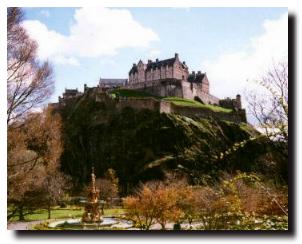 There cannot be many cities in the world where the foremost shopping street has an uninterrupted view of an historic, medieval castle due to retail outlets being built along one side of the street. But that is Edinburgh's Princes Street. In the more commercially minded city of Glasgow, there are some Philistines who think that Princes Street is only half built...
There cannot be many cities in the world where the foremost shopping street has an uninterrupted view of an historic, medieval castle due to retail outlets being built along one side of the street. But that is Edinburgh's Princes Street. In the more commercially minded city of Glasgow, there are some Philistines who think that Princes Street is only half built...
Princes Street was part of the "New Town" of Edinburgh, which was built in the latter half of the 18th century during the reign of the Hanoverian King George III. Princes Street was named after King George's sons - but only after the King had objected to its original name - St Giles Street, the patron saint of the city.
This description of Princes Street is divided into two sections - the south side of the street which includes the gardens and castle and, on the second page, a quick tour of the retail outlets on the north side of the street.
Princes Street Gardens
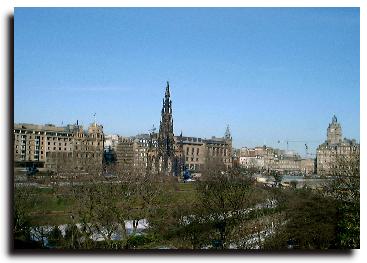 It is a surprise to many visitors to find that, tucked underneath Edinburgh Castle and running the full length of the gardens is a railway line going into Waverley Station. The Victorians, with their enthusiasm for railways, did not have to contend with City Council planning regulations and conservation groups! Thankfully, however, they did create a deep cutting so that it is not visible from the street but in the days of steam, the trains puffing their way from the station could be heard and the smoke seen billowing into the sky.
It is a surprise to many visitors to find that, tucked underneath Edinburgh Castle and running the full length of the gardens is a railway line going into Waverley Station. The Victorians, with their enthusiasm for railways, did not have to contend with City Council planning regulations and conservation groups! Thankfully, however, they did create a deep cutting so that it is not visible from the street but in the days of steam, the trains puffing their way from the station could be heard and the smoke seen billowing into the sky.
The railway companies often built luxurious hotels beside their main stations and Waverley Station was no exception. Originally built as the North British Hotel, the renamed Balmoral Hotel is seen on the right of the picture above. Leading off Princes Street is the Waverley Bridge beside the station. Tour buses and buses to the airport leave from here.
At the corner of Waverley Bridge and Princes Street and beside the station is the Princes Mall. This is two and a half floors of small boutique shops and a food court selling fast food. Most of this building has been constructed under ground. On the top, is the main tourist information bureau where you can get advice about the city and book accommodation in Edinburgh.
The 200 feet high Sir Walter Scott Monument dominates this end of Princes Street. The stonework has blackened over the years and currently has a "piebald" effect from recent repairs. There are 287 steps to the top but the views from there of the Edinburgh skyline (if you can make it up all those stairs) are tremendous.
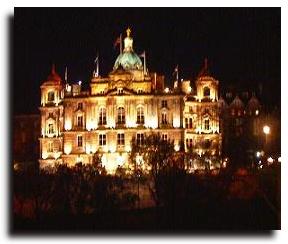
High above East Princes Street Gardens is the Bank of Scotland head office (which is lit up at night - as the picture here shows). In order to ensure that nobody built in front of them, the Bank bought the land in front, part of which has become East Princes Street Gardens.
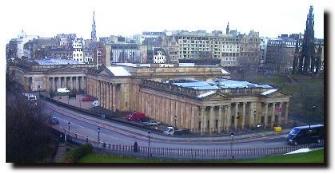 The first road off Princes Street on the south side is "The Mound". Originally, the old city of Edinburgh ran down the "spine" of the Royal Mile from the castle to the Palace of Holyroodhouse. There was a stagnant "Nor' Loch" below the castle which was used as a receptacle for sewage. With the building of the "New Town" a street called The Mound (see above) was built of waste material which linked the old and new parts of the city. In the 19th century, the Royal Scottish Academy and the National Gallery of Scotland, with their Grecian-style columns, were built at the junction of The Mound and Princes Street. Near the top of The Mound are the twin spires of what was once the Church of Scotland Assembly Hall - now the temporary home of the Scottish Parliament. The picture above was taken from just in front of the Parliament building, looking north.
The first road off Princes Street on the south side is "The Mound". Originally, the old city of Edinburgh ran down the "spine" of the Royal Mile from the castle to the Palace of Holyroodhouse. There was a stagnant "Nor' Loch" below the castle which was used as a receptacle for sewage. With the building of the "New Town" a street called The Mound (see above) was built of waste material which linked the old and new parts of the city. In the 19th century, the Royal Scottish Academy and the National Gallery of Scotland, with their Grecian-style columns, were built at the junction of The Mound and Princes Street. Near the top of The Mound are the twin spires of what was once the Church of Scotland Assembly Hall - now the temporary home of the Scottish Parliament. The picture above was taken from just in front of the Parliament building, looking north.
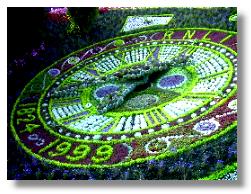 On the other corner of The Mound is the famous Floral Clock. This is replanted every year and the moving hands of the clock as well as its face are covered in plants, mainly sempervivums. Above the clock stands a carrara marble statue of Allan Ramsay. Across the gardens and clinging to the side of the rock beside the castle are the houses of Ramsay Gardens.
On the other corner of The Mound is the famous Floral Clock. This is replanted every year and the moving hands of the clock as well as its face are covered in plants, mainly sempervivums. Above the clock stands a carrara marble statue of Allan Ramsay. Across the gardens and clinging to the side of the rock beside the castle are the houses of Ramsay Gardens.
 Further along Princes Street is the striking equestrian memorial to the Royal Scots Greys. Nearby, within the gardens themselves, is the Scottish American War Memorial. Also in the gardens at this point is the Ross Bandstand. This is not used very often, except during the Edinburgh Festival.
Further along Princes Street is the striking equestrian memorial to the Royal Scots Greys. Nearby, within the gardens themselves, is the Scottish American War Memorial. Also in the gardens at this point is the Ross Bandstand. This is not used very often, except during the Edinburgh Festival.
At the far end of the gardens, the water in the gilded Ross Fountain (pictured here) did not flow for many years but a joint project involving Edinburgh City Council and East of Scotland Water has got it going again - with the water being recycled as required by current environmental regulations.
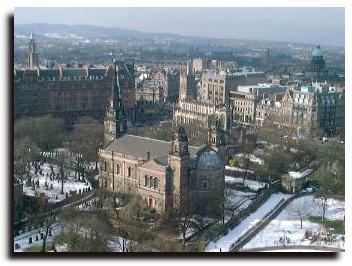 At the far end of the south side of Princes Street are two churches - St John's at the corner of Lothian Road and St Cuthbert's (the large building in the foreground of the picture above, which was taken from the ramparts of Edinburgh castle in winter time, after a fall of snow).
At the far end of the south side of Princes Street are two churches - St John's at the corner of Lothian Road and St Cuthbert's (the large building in the foreground of the picture above, which was taken from the ramparts of Edinburgh castle in winter time, after a fall of snow).
Just as Princes Street began with a former railway hotel, it ends with another one. This time it is the large, red sandstone structure of the Caledonian Hotel, visible on the left of the picture here. This is a favourite stopping off place for Sean Connery and many other celebrities.



